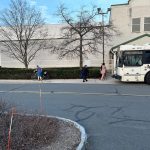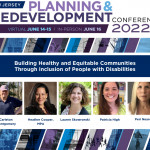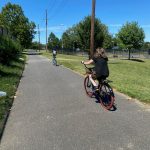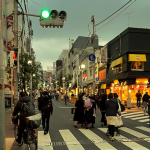New Jersey Future Blog
Beyond Getting from A to B: Ensuring Safer and Fairer Ways to Move Around
July 8th, 2022 by Michael Atkins
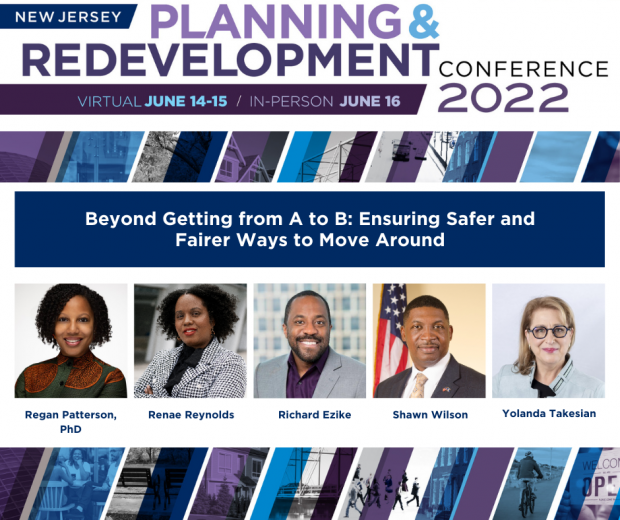 Transportation emissions comprise over 40% of New Jersey’s total greenhouse gases (GHG). Expanding bus and rail transportation options beyond cars not only addresses reduction of GHGs, it also increases affordability and improves general public health by getting transit users to walk or bike to popular modes of mass transit. In encouraging further adoption of public transit, planners, transportation agencies, and civic leaders must establish safety and fairness in order to achieve less vehicle miles traveled (VMT) to meet our climate change goals and foster healthy, walkable communities throughout New Jersey.
Transportation emissions comprise over 40% of New Jersey’s total greenhouse gases (GHG). Expanding bus and rail transportation options beyond cars not only addresses reduction of GHGs, it also increases affordability and improves general public health by getting transit users to walk or bike to popular modes of mass transit. In encouraging further adoption of public transit, planners, transportation agencies, and civic leaders must establish safety and fairness in order to achieve less vehicle miles traveled (VMT) to meet our climate change goals and foster healthy, walkable communities throughout New Jersey.
A panel titled “Beyond Getting from A to B: Ensuring Safer and Fairer Ways to Move Around” addressed just these intersecting issues at the 2022 NJ Planning and Redevelopment Conference (NJPRC), sponsored by New Jersey Future and the New Jersey chapter of the American Planning Association.
Transportation today showcases a number of inequities in our built environment ranging from air quality to accessibility. Historically, federal funding and state departments of transportation (DOTs) have measured successful projects by vehicle speeds, which has incentivized the erection of freeways and their widening to attempt to alleviate congestion. This emphasis also encourages even persons of limited means in our society to consider the world as car-centric. Now, a shift in attitudes has led transportation professionals and officials to prioritize multi-modal and public transportation options, in order to ensure safety and equity to increase transit ridership, thereby reducing VMTs.
Panelists brought a broad range of experiences to the discussion, and an even greater depth of on-the-ground experience. They included: moderator Renae Reynolds, Executive Director of the Tri-State Transportation Campaign; Regan Patterson, PhD, Transportation Equity Research Fellow with the Congressional Black Caucus Foundation; Richard Ezike, PhD, Director of Infrastructure and Planning at CHPlanning Limited; Shawn Wilson, PhD, Secretary of the Louisiana Department of Transportation and Development and President of the American Association of State Highway and Transportation Officials (AASHTO); and Yolanda Takesian, Principal Planner of Kittelson & Associates.
In his keynote remarks, panelist Dr. Shawn Wilson conceded there is ample room for improvement within the transit sector. “The development of the transportation system has historically prioritized highways and focused on a limited range of users. That’s just the history of where we are.” Wilson reported that AASHTO’s Board of Directors passed a unanimous declaration in 2020 acknowledging the inequities of the past, and the negative impacts these transportation priorities have disproportionately affected Black and Brown communities. “As the state DOT community, we are committed to serve as stewards of an integrated, multi-modal transportation system that achieves economic, environmental, and social goals set by the representatives of the people we serve.”
Dr. Regan Patterson noted a disproportionate impact transportation inequality has on women, and the challenges they face in all modes of transportation. “Gender is as important as a disparity as race. Women are predominantly the caregivers of their family, so if the primary person needing care is in a wheelchair or is a child, is the sidewalk safe for their usage? Do women feel safe when walking or riding public transportation?”
“The most unsafe place for a pedestrian to be is within the vicinity of a bus stop,” warned paneliest Yolanda Takesian. “Adding a safety metric is crucial,” she added while highlighting the impacts of Vision Zero and Complete Streets programs across American cities to transform urban arterials – where jobs, restaurants, and retail stores often cluster – into safe pedestrian corridors, with protected bike lanes, and frequent bus service.
Takesian emphasized the importance of community conversations in building popular support behind these streetscape adjustments and encouraged community leaders and engineers to make the time to develop personal connections with the corridors they plan and redesign. “We need to recognize the value of lived experience” in reimagining our transportation system.
Dr. Richard Ezike built upon this prescription, suggesting the key to success is to ensure that “the community feels like they are being listened to and being heard and have a say in actual development.” Ezike supported the idea that the adjustment away from speeds is improving safety and access throughout the transportation system. Ezike also noted that “workforce development builds equity” and that hiring practices in resurfacing and redesigning streets to be people-oriented is a major opportunity to train and employ members of underserved communities.
Dr. Patterson pointed to consistent community organizing around environmental justice that has built energy behind audacious adjustments, such as highway removal in the states of California and Washington, and the allocation of Federal funding to address these issues throughout the nation. Audience members demonstrated a particularly acute interest in urban highway removal and historic inequities with state DOTs and the Federal Highway (FHWA).
Dr. Wilson offered an important perspective to attendees and panelists interested in addressing safety and equity in adapting our sprawling transportation system to 21st century challenges. Wilson noted the tendency to scale projects too big (to attract more funding in transforming a corridor), or too small (to avoid controversy, or in the name of expediency.). “We scale [transit] projects to multi-billion dollar size that are unaffordable, or conduct spot improvement projects that address a collision hotspot but ignore corridor connectivity.” While transportation agencies, planners and the public agree that safety and access are primary objectives in updating our transportation infrastructure, it remains a long road to hoe to realize a more equitable and inclusive system. Reimagining our transportation system includes remaking our cities and towns to offer a plethora of transit options and for those options to be safe and inclusive for all types of riders. In doing so, we can reduce our harmful emissions while improving affordability and public health outcomes with a robust multi-modal transportation system.
Related Posts
Tags: accessibility, biking, conference, equity, inclusion, public transit, Transportation, vehicle miles traveled (VMT), walking

